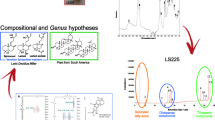Abstract
Residues from medicine containers in the collections of the British Museum have been investigated as part of a wider programme of scientific work on Roman surgical instruments. The cylindrical bronze containers are often described as instrument cases, but some contain materia medica, ranging from extensive extant remains of ancient preparations to possible minor deposits on the interior surfaces of the containers. Samples from seven residues have been analysed by gas chromatography–mass spectrometry (GC-MS) to identify lipid, resin and carbohydrate components and by X-ray fluorescence and Raman spectroscopy to characterise inorganic materials. The results have provided evidence for ointments and powders or pills consistent with a medical purpose. The ingredients identified include beeswax, fat, conifer resin and gum-derived sugars, plus elemental carbon and lead and zinc salts. Particularly significant were the varied compositions of residues from four sections of a multi-compartment container. In one of these compartments, the beeswax seems to have been prepared as the ‘Punic wax’ described by Pliny. Experimental preparation of Punic wax following Pliny’s method was undertaken in the laboratory and the product analysed to compare with the ointment residues. This paper discusses the GC-MS results of both the experimental material and the archaeological residues and their significance for the interpretation of the past intended applications of the medicines and the use of the containers.





Similar content being viewed by others
References
Jackson R (1986) Britannia 17:119–167
Jackson R (1990) Journal of Roman Archaeology 3:5–27
Bleton J, Mejanelle P, Sansoulet J, Goursaud S, Tchapla A (1996) J Chromatogr A 720:27–49
McCloskey JA (1970) In: Gunstone FD (ed) Topics in lipid chemistry. Logos Press, London
Evershed RP (1992) In: Hamilton RJ, Hamilton S (eds) Lipid analysis. A practical approach. Oxford University Press, Oxford
Pastorova I, van der Berg KJ, Boon JJ, Verhoeven JW (1997) Journal of Analytical and Applied Pyrolysis 43:41–57
Cowell M (1998) In: Oddy A, Cowell M (eds) Metallurgy in numismatics. Royal Numismatic Society, London
Pliny (1961) Natural history, vol IV (translated by H. Rackham). William Heinemann, London
Foster GV, Kanada K (1988) In: A Roman surgeon’s tomb from Nea Paphos. Part II: Ancient medicines: by-products of copper mining in Cyprus. Report of the Department of Antiquities, Cyprus
Mills JS, White R (1994) The organic chemistry of museum objects. Butterworth-Heinmann, Oxford
Vallance SL, Singer BW, Hitchen SM, Townsend JH (1998) Journal of the American Institute for Conservation 37:294–311
Ha YW, Thomas RL (1988) J Food Sci 53:574–577
Al-Hazmi MI, Stauffer KR (1986) J Food Sci 51:1091–1097
Heron C, Nemcek N, Bonfield KM, Dixon D, Ottaway BS (1994) Naturwissenschaften 81:266–268
Evershed RP, Vaughan SJ, Dudd SN, Soles JS (1997) Antiquity 71:979–985
Regert M, Colinart S, Degrand L, Decavallas O (2001) Archaeometry 43:549–569
Blau K, Halket JM (1993) Handbook of derivatives for chromatography. Wiley, Chichester
Kuhn H (1960) Detection and identification of waxes, including Punic wax, by infra-red spectrography. Studies in Conservation 5:71–81
White R (1978) Studies in Conservation 23:57–68
Colinart S, Grappin-Wsevolojsky S, Matray C (1999) In: Bridgeland J (ed) 12th Triennial Meeting, Lyon, 29 August–3 September 1999: preprints (ICOM Committee for Conservation). James and James Ltd.
Miliani C, Daveri A, Spaabaek L, Romani A, Manuali V, Sgamellotti A, Brunetti BG (2010) Appl Phys A 100:703–711
Ramer B (1979) Studies in Conservation 24:1–13
Robinet L, Corbeil M-C (2003) Studies in Conservation 48:23–40
Regert M, Dudd SN, Van Bergen PF, Pétrequin P, Evershed RP (1998) In: Millard A (ed) Archaeological sciences 1997. Oxbow, Oxford
Serpico M, White R (2000) In: Nicholson PT, Shaw I (eds) Ancient Egyptian materials and technology. Cambridge University Press, Cambridge
Evershed RP, Berstan R, Grew F, Copley MS, Charmant AJH, Barham E, Mottram HR, Brown G (2004) Nature 432:35–36
Celsus (1938) De Medicina, vol II (translated by W. G. Spencer). William Heinemann, London
Dioscorides A (2000) In: Osbaldeston TA (ed) The herbal of Dioscorides the Greek. IBIDIS Press, Johannesburg
Tegethoff FW, Rohleder J, Kroker E (2001) Calcium carbonate: from the Cretaceous period into the 21st century. Birkhäuser, Basel
Acknowledgements
I am indebted to colleagues who contributed to the analytical work on these residues, especially Duncan Hook for assistance with XRF analysis and Janet Ambers who carried out the Raman spectroscopy. Access to residue inside the fourth section of the multi-compartment cylinder was made possible by Marilyn Hockey’s careful conservation work to open this compartment. Susan La Niece made available her earlier XRD analysis of the material and carried out the radiography of the multi-compartment cylinder. Special thanks are due to Ralph Jackson for instigating the investigation, for his enthusiastic interest in and discussions of the findings. I am grateful to all colleagues who read and commented on the draft manuscript and for the helpful suggestions of three anonymous reviewers.
Author information
Authors and Affiliations
Corresponding author
Additional information
Published in the special issue Analytical Chemistry to Illuminate the Past with guest editor Maria Perla Colombini.
Rights and permissions
About this article
Cite this article
Stacey, R.J. The composition of some Roman medicines: evidence for Pliny’s Punic wax?. Anal Bioanal Chem 401, 1749–1759 (2011). https://doi.org/10.1007/s00216-011-5160-7
Received:
Revised:
Accepted:
Published:
Issue Date:
DOI: https://doi.org/10.1007/s00216-011-5160-7




